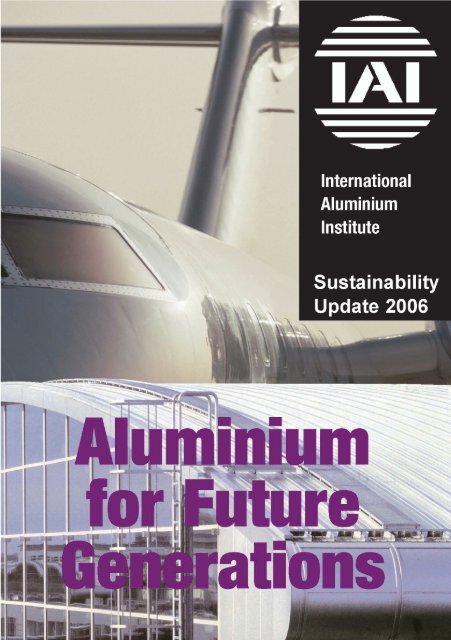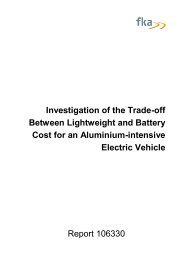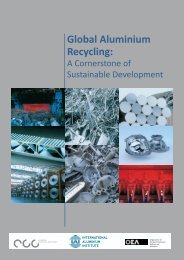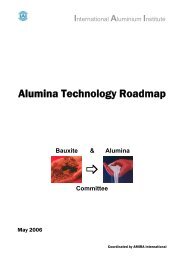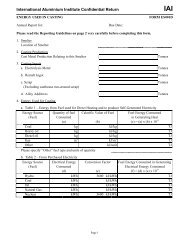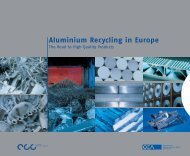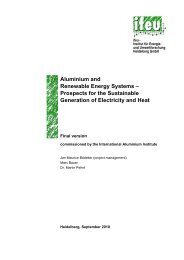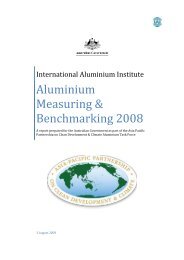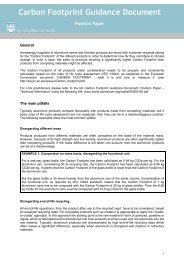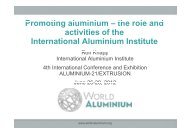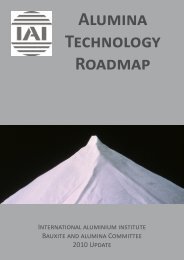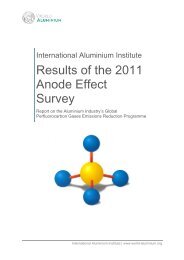aluminium for future generations sustainability - International ...
aluminium for future generations sustainability - International ...
aluminium for future generations sustainability - International ...
You also want an ePaper? Increase the reach of your titles
YUMPU automatically turns print PDFs into web optimized ePapers that Google loves.
ALUMINIUM FOR FUTURE<br />
GENERATIONS<br />
The Aluminium <strong>for</strong> Future Generations initiative is<br />
a programme of continuous improvement on the<br />
part of the global <strong>aluminium</strong> industry, overseen by<br />
the <strong>International</strong> Aluminium Institute (IAI). It<br />
comprises voluntary objectives, currently thirteen in<br />
number but increasing year by year, related to all<br />
key phases of <strong>aluminium</strong>’s life cycle. The<br />
industry’s per<strong>for</strong>mance towards meeting these<br />
objectives is measured annually against twenty two<br />
per<strong>for</strong>mance indicators. This update reports on<br />
year 2005 per<strong>for</strong>mance recorded in the annual<br />
survey of <strong>sustainability</strong> data collected from IAI<br />
member companies, collectively responsible <strong>for</strong><br />
over 70% of global primary <strong>aluminium</strong> production<br />
and around 20% of recycled metal production. For<br />
further in<strong>for</strong>mation on IAI members, please visit the<br />
World Aluminium website.<br />
This year survey data was collected from:<br />
• 75 smelters representing almost 18 million<br />
tonnes of primary <strong>aluminium</strong> production, a<br />
21% increase on 2004 coverage and<br />
equivalent to 55% of total global <strong>aluminium</strong><br />
production;<br />
• 24 refineries representing over 36 million<br />
tonnes of smelter grade alumina, a 41%<br />
increase on 2004 coverage and equivalent to<br />
around 60% of total global alumina production;<br />
• 11 mines representing over 81 million tonnes<br />
of bauxite, a 13% increase on 2004 coverage<br />
and equivalent to around 50% of total global<br />
bauxite production.<br />
2005 Sustainability Per<strong>for</strong>mance<br />
Voluntary Objective 1<br />
An 80% reduction in Perfluorocarbon (PFC)<br />
greenhouse gas emissions per tonne of <strong>aluminium</strong><br />
produced <strong>for</strong> the industry as a whole by 2010<br />
versus 1990 levels.<br />
Tonnes CO2 equivalent per tonne<br />
<strong>aluminium</strong> produced<br />
5<br />
4<br />
3<br />
2<br />
1<br />
0<br />
4.4<br />
1990<br />
1992<br />
1.0<br />
1994<br />
1996<br />
1998<br />
2000<br />
2002<br />
2004<br />
2006<br />
0.9<br />
2008<br />
2010<br />
PFC emissions from the global <strong>aluminium</strong> industry<br />
have been reduced by 76% per tonne of <strong>aluminium</strong><br />
produced between 1990 and 2005. Total PFC<br />
emissions have been reduced by over 60%<br />
1<br />
between 1990 and 2005, even though total primary<br />
production has increased from 20 to over 30 million<br />
tonnes per annum in the same period.<br />
PFCs are potent greenhouse gases with long<br />
atmospheric lifetimes, <strong>for</strong>med in the <strong>aluminium</strong><br />
smelting process during brief upset conditions<br />
known as ‘anode effects’. The improvement in<br />
PFC emissions per<strong>for</strong>mance over the last fifteen<br />
years is in part due to a heightened awareness at<br />
all levels within companies and the availability of<br />
facility benchmarking data and sharing of best<br />
practices to reduce the frequency of anode effects.<br />
Current global PFC emissions per<strong>for</strong>mance is<br />
equivalent to a reduction of over 3 tonnes of CO2<br />
per tonne of <strong>aluminium</strong> produced since 1990.<br />
Voluntary Objective 2<br />
A minimum of a 33% reduction in fluoride<br />
emissions by IAI member companies per tonne of<br />
<strong>aluminium</strong> produced by 2010 versus 1990.<br />
Data collected from facilities representing 83% of<br />
IAI member company production indicate a<br />
reduction in total fluoride emissions (gaseous and<br />
particulate) of over 50% per tonne of <strong>aluminium</strong><br />
produced between 1990 and 2005.<br />
Voluntary Objective 3<br />
A 10% reduction in average smelting energy usage<br />
by IAI member companies per tonne of <strong>aluminium</strong><br />
produced by 2010 versus 1990.<br />
Megawatt hours per tonne<br />
<strong>aluminium</strong> produced<br />
16.2<br />
16.0<br />
15.8<br />
15.6<br />
15.4<br />
15.2<br />
15.0<br />
14.8<br />
14.6<br />
14.4<br />
16.1<br />
1990<br />
1992<br />
15.3<br />
1994<br />
1996<br />
1998<br />
2000<br />
2002<br />
2004<br />
2006<br />
2008<br />
14.5<br />
2010<br />
The average electrical energy required to smelt<br />
one tonne of <strong>aluminium</strong> from alumina has been cut<br />
by 5% between 1990 and 2005, mainly through<br />
investment in modern, more efficient technologies.<br />
New smelters generally utilise best available<br />
technologies, no matter where in the world they are<br />
located and the IAI is helping producers to share<br />
knowledge and best practice to improve energy<br />
efficiency.
Voluntary Objective 4<br />
A 50% reduction in the lost time accident rate and<br />
recordable accident rate by 2010 versus 2000 by<br />
IAI member companies, with a review in 2006.<br />
Safety per<strong>for</strong>mance data is collected in a separate<br />
survey which has a wider reporting base than the<br />
IAI membership. The survey was initiated in 1997,<br />
with a coverage of 107 million working hours. By<br />
2002 the number of working hours surveyed had<br />
risen to 315 million and by 2005 to 411 million.<br />
The survey now covers 98 <strong>aluminium</strong> smelters, 34<br />
alumina refineries and 15 bauxite mines.<br />
Per million hours worked<br />
30<br />
25<br />
20<br />
15<br />
10<br />
5<br />
0<br />
1997 1998 1999 2000 2001 2002 2003 2004 2005<br />
Lost Time Accident Rate<br />
Recordable Accident Rate<br />
The recordable accident rate at reporting plants<br />
has been cut by 75% over the period 2000-2005.<br />
The lost time accident rate has been reduced by<br />
64% over the same period. A focus on improving<br />
accident rates has also seen the number of days<br />
lost per accident (the severity rate) decrease by<br />
60% from 1997 to 2005.<br />
Lost Time Accident Rate<br />
(Injuries per million hours<br />
worked)<br />
8<br />
7<br />
6<br />
5<br />
4<br />
3<br />
2<br />
1<br />
0<br />
2004<br />
2005<br />
1998<br />
1999<br />
2000 2001<br />
2002<br />
2003<br />
1997<br />
0 50 100 150 200<br />
Severity Rate<br />
(Days lost per million hours worked)<br />
The improvement in the industry’s accident rates is<br />
being driven by factors including increased top<br />
management attention and commitment on safety,<br />
more systematic accident follow up and increased<br />
involvement of the work<strong>for</strong>ce, as well as<br />
mechanization and automation as a means to<br />
improving technical conditions.<br />
While continuing to improve on these rates, the<br />
industry is now focusing on reducing the severity of<br />
accidents and on preventing fatalities by compiling<br />
guidelines based on best practice from the<br />
worldwide industry. Most serious accidents involve<br />
2<br />
mobile equipment and cranes and other lifting<br />
devices. In 2004, 35% of all fatal accidents were<br />
traffic-related while in 2005 this figure was 25%.<br />
The IAI has developed a set<br />
of safety guidelines <strong>for</strong><br />
mobile equipment based on<br />
the shared procedures and<br />
experiences of a number of<br />
<strong>aluminium</strong> companies in<br />
managing the risks involved<br />
in mobile equipment and<br />
pedestrian segregation.<br />
These guidelines have been made available to the<br />
<strong>aluminium</strong> industry (member and non-member<br />
companies) and other industries. Further<br />
guidelines on cranes and lifting devices are also<br />
being developed.<br />
Future Priority areas include:<br />
• The concentration of management actions on<br />
the operation of mobile equipment, cranes and<br />
lifting devices;<br />
• Improving rules, procedures and work<br />
standards;<br />
• Improving equipment design and engineering;<br />
• Improving training in the use of equipment;<br />
• Addressing behaviour based safety.<br />
• Drafting an IAI Safety Audit Protocol to be<br />
used in connection with a generic occupational<br />
health and safety audit of member companies.<br />
Voluntary Objective 5<br />
Implementation of Management Systems <strong>for</strong><br />
Environment (including ISO 14000 or equivalent<br />
certification) and <strong>for</strong> Health and Safety in 95% of<br />
IAI member companies’ plants by 2010.<br />
92% of plants surveyed have such management<br />
systems in place, with 82% having ISO 14000,<br />
compared to around 60% in 2004, and 20% having<br />
OHSAS 18000, compared to around 10% in 2004.<br />
Voluntary Objective 6<br />
Implementation of an Employee Exposure<br />
Assessment and Medical Surveillance Programme<br />
in 95% of IAI member companies’ plants by 2010.<br />
Employee exposure assessment and medical<br />
surveillance programmes are in place at 89% of IAI<br />
member company plants. A detailed industry-wide<br />
definition of criteria required to meet this objective<br />
was included with the survey questionnaire this<br />
year and so the data from 2005 can be considered<br />
more robust than those from 2004, which gave a<br />
figure of 92%.
Voluntary Objective 7<br />
The industry will monitor annually <strong>aluminium</strong><br />
shipments <strong>for</strong> use in transport in order to track<br />
<strong>aluminium</strong>'s contribution through light-weighting to<br />
reducing greenhouse gas (GHG) emissions from<br />
road, rail and sea transport.<br />
Aluminium shipments to the automotive and light<br />
truck industries increased by over 20% in the last<br />
five years. Global greenhouse gas savings from<br />
the use of <strong>aluminium</strong> <strong>for</strong> lightweighting vehicles<br />
have the potential to double between 2005 and<br />
2020 to 500 million tonnes of CO2 per year.<br />
Voluntary Objective 8<br />
The IAI has developed a mass flow model to<br />
identify <strong>future</strong> recycling flows. The industry will<br />
report regularly on its global recycling<br />
per<strong>for</strong>mance.<br />
Aluminium is a metal that can be recycled and reused<br />
almost endlessly. Further, the recycling of<br />
the metal uses as little as 5% of the energy that<br />
would be required to produce it from raw materials.<br />
This property of recyclability means that the world’s<br />
increasing stock of <strong>aluminium</strong> acts like an “energy<br />
resource bank”, over time delivering more and<br />
more practical use and value from the energy<br />
embodied in the metal at the time of its production.<br />
Of an estimated total of over 700 million tonnes of<br />
<strong>aluminium</strong> produced in the world since commercial<br />
manufacture began, about three quarters is still in<br />
productive use.<br />
Total <strong>aluminium</strong> production<br />
(million tonnes per year)<br />
80<br />
70<br />
60<br />
50<br />
40<br />
30<br />
20<br />
10<br />
0<br />
1950<br />
1960<br />
1970<br />
1980<br />
1990<br />
2000<br />
2010<br />
2020<br />
90<br />
80<br />
70<br />
60<br />
50<br />
40<br />
30<br />
20<br />
10<br />
0<br />
Ratio of primary and recycled<br />
<strong>aluminium</strong> production (%)<br />
Total Metal Production Primary Production<br />
Recycling Production<br />
The contribution of scrap metal “resource” to the<br />
global output of <strong>aluminium</strong> metal has increased<br />
from 17% in 1960 to 33% today and is projected to<br />
rise to almost 40% by 2020.<br />
Recycling of post-consumer <strong>aluminium</strong> now saves<br />
an estimated 84 million tonnes of greenhouse gas<br />
emissions per year, equivalent to the annual<br />
3<br />
emissions from 15 million cars. Since its inception,<br />
the recycling of post-consumer <strong>aluminium</strong> scrap<br />
has already avoided over one billion metric tonnes<br />
of CO2 emissions.<br />
Aluminium recycling benefits present and <strong>future</strong><br />
<strong>generations</strong> by conserving energy and other<br />
natural resources. The recycling of <strong>aluminium</strong><br />
requires up to 95% less energy than that required<br />
<strong>for</strong> primary <strong>aluminium</strong> production, thereby avoiding<br />
corresponding emissions, including greenhouse<br />
gases. The production of <strong>aluminium</strong> from scrap<br />
also reduces the amount of waste from used<br />
products, conserving landfill space. At the end of<br />
their useful life, products made from <strong>aluminium</strong> can<br />
be infinitely recycled without any loss of quality to<br />
produce new products. That means <strong>aluminium</strong> can<br />
be recycled <strong>for</strong> use in almost all <strong>aluminium</strong><br />
applications since its atomic structure is not altered<br />
during melting.<br />
The <strong>aluminium</strong> recycling industry recycles all the<br />
<strong>aluminium</strong> scrap it can obtain from end-of-life<br />
products and <strong>aluminium</strong> by-products. The<br />
recycling rate at which end-of-life <strong>aluminium</strong> is<br />
recycled varies depending on the product sector,<br />
the lifetime of each product and on society’s<br />
commitment to collect <strong>aluminium</strong>. Each application<br />
requires its own recycling solutions. Just over 15<br />
million tonnes of recycled <strong>aluminium</strong> were<br />
produced in 2004 worldwide, which met 33% of the<br />
global demand <strong>for</strong> <strong>aluminium</strong>. Of the almost 7<br />
million tonnes of <strong>aluminium</strong> recycled from end-oflife<br />
products 28% came from packaging, 44% from<br />
transport, 7% from building and 21% from other<br />
products. Global <strong>aluminium</strong> recycling rates are<br />
high, approximately 90% <strong>for</strong> transport and around<br />
60% <strong>for</strong> beverage cans. Aluminium enjoys a high<br />
recycling rate of 85% in the building industry. The<br />
global industry is keen to increase collection rates<br />
and is working with producers of building<br />
applications to enable even more efficient<br />
collection of scrap from demolished buildings. In<br />
2004 Delft University of Technology conducted a<br />
study into the <strong>aluminium</strong> content of, and collection<br />
rates from, demolished buildings in six European<br />
countries, which found that the average collection<br />
rate <strong>for</strong> <strong>aluminium</strong> was close to 96%.<br />
In 2004, approximately 30% of wrought and<br />
casting alloys put on the market were used in cars,<br />
commercial vehicles, aeroplanes, trains, ships, etc.<br />
Increasingly, <strong>aluminium</strong> products are being<br />
employed to reduce vehicle weights, without loss<br />
of per<strong>for</strong>mance, improving safety and potentially<br />
reducing greenhouse gas emissions from vehicles’<br />
use-phase. Consequently, the transport sector is<br />
also a major source of <strong>aluminium</strong> at the end of<br />
vehicle lifetimes. The transport sector has high<br />
rates of recycling, currently about 90% globally<br />
because dismantlers and recyclers recognise the<br />
high intrinsic value of end-of-life <strong>aluminium</strong>
products. The <strong>aluminium</strong> industry is working with<br />
manufacturers to enable easier dismantling of<br />
<strong>aluminium</strong> automotive components to improve the<br />
sorting and recovery of scrap <strong>aluminium</strong>. The<br />
Japanese Aluminium Association, <strong>for</strong> example, is<br />
currently undertaking a study of advanced<br />
separation techniques to identify ways in which<br />
<strong>aluminium</strong> components from Shinkansen ‘Bullet<br />
Train’ carriages can be efficiently separated from<br />
other materials, thus increasing the recycling rate<br />
and the quality of scrap collected. Electromagnetic<br />
sorting is a powerful tool, currently used in many<br />
regions of the world, which separates even the<br />
smallest <strong>aluminium</strong> shards from waste material.<br />
Applying heat to end of life vehicle parts to<br />
separate the lacquer from the <strong>aluminium</strong> also<br />
facilitates recycling.<br />
Used beverage cans are normally back on sale as<br />
new beverage cans or other <strong>aluminium</strong> products in<br />
five to eight weeks in those countries which have<br />
dedicated can collecting and recycling schemes.<br />
Can collection is around 60% globally and in some<br />
countries the collection rate is already above 80%.<br />
Sweden and Switzerland collect 86% and 88% of<br />
their <strong>aluminium</strong> beverage cans, respectively.<br />
Sweden’s success lies in a deposit/refund system<br />
whereas in Switzerland a voluntary prepaid<br />
recycling charge covers the costs of collection. In<br />
Japan a collection rate <strong>for</strong> used beverage cans of<br />
92% is achieved with a voluntary system.<br />
Used <strong>aluminium</strong> cans are worth six to twenty times<br />
more than any other used packaging material.<br />
Recycling is not mandatory in Brazil, but every<br />
region in Brazil has a recycling market which<br />
facilitates the collection and transportation of endof-life<br />
products. This has encouraged<br />
communities, supermarkets, condominiums,<br />
shopping centres and clubs to collect. As a result<br />
in 2005, 96% of cans were recycled in Brazil and<br />
Bauxite 5 153.7<br />
Primary<br />
Aluminium used<br />
30.2<br />
Remelted<br />
Aluminium 31.6<br />
o.a.Recycled<br />
Aluminium 15.1<br />
Bauxite Residues 56.7<br />
and Water 39.7<br />
MATERIAL FLOW<br />
Alumina 6 57.3<br />
Traded<br />
New<br />
Scrap 1 1.3<br />
Ingots 61.8<br />
METAL FLOW<br />
Fabricator<br />
Scrap 2<br />
16.5<br />
Fabricated and<br />
Finished<br />
Products (input)<br />
60.5<br />
4<br />
this is being considered the world’s highest<br />
recycling rate <strong>for</strong> used beverage cans.<br />
To gain additional knowledge about the recycling<br />
rates of <strong>aluminium</strong> contained in consumer durables<br />
(e.g., cooking utensils, consumer electronics) and<br />
machinery further investigations are under way.<br />
The principal limiting factor on increasing the<br />
recycling rate is not <strong>aluminium</strong> itself but the<br />
collection of end-of-life product material. Societies,<br />
governments and communities need to work<br />
alongside the industry to create effective recycling<br />
systems to ensure the constant improvement of<br />
recycling rates in all applications sectors.<br />
The IAI has designed a mass flow model (critically<br />
reviewed by Yale and Delft Technical Universities)<br />
to track <strong>aluminium</strong> throughout its lifecycle from<br />
mining to product use to recycling. The main<br />
objective <strong>for</strong> creating the model is to identify<br />
present and <strong>future</strong> recycling flows and the scope<br />
<strong>for</strong> further recycling. The model traces the flow of<br />
<strong>aluminium</strong> from 1888 to the present along the<br />
complete value chain. Eight major processes are<br />
investigated: bauxite mining, alumina refining,<br />
<strong>aluminium</strong> and <strong>aluminium</strong> ingot production,<br />
fabrication (rolling, extrusion and casting),<br />
manufacturing (production and assembly of<br />
finished products), use and recycling. New scrap<br />
is generated immediately during the production<br />
and processing stages, not having yet reached the<br />
use phase. Old scrap is generated when an<br />
<strong>aluminium</strong> containing product reaches its end-oflife<br />
and is collected <strong>for</strong> recycling. To calculate the<br />
amount of <strong>aluminium</strong> still in productive use and<br />
leaving the use stage a product residence time<br />
model is applied. Here the average lifetime of<br />
each of the main products in which <strong>aluminium</strong> is<br />
used, and the historical tonnage of <strong>aluminium</strong> in<br />
those products is considered. The results <strong>for</strong> 2004<br />
are shown in mass flow diagram below.<br />
Other<br />
Applications 3<br />
1.1<br />
Finished<br />
Products (output)<br />
36.3<br />
Traded<br />
New<br />
Scrap 7 7.7<br />
Old<br />
Scrap<br />
7.4<br />
Total Products<br />
Stored in Use<br />
Since 1888<br />
538.5<br />
Building 31%<br />
Transport 28%<br />
o.a.Automotive16%<br />
Net Addition 2004: 21.1<br />
Packaging 1%<br />
Other 11% Engineering<br />
and Cable 29%<br />
Metal Losses 1.3 Not Recycled in 2004 8 3.4 Under Investigation 4 3.3<br />
Values in millions of metric tonnes. Values might not add up due to rounding. Production stocks not shown<br />
1 Aluminium in skimmings; 2 Scrap generated by foundries, rolling mills and extruders. Most is internal scrap and not taken into account in statistics; 3 Such as powder, paste and<br />
deoxidation <strong>aluminium</strong> (metal property is lost ) 4 Area of current research to identify final <strong>aluminium</strong> destination (reuse, recycling or landfilling); 5 Calculated. Includes, depending<br />
on the ore, between 30% and 50% alumina; 6 Calculated. Includes on a global average 52% <strong>aluminium</strong>; 7 Scrap generated during the production of finished products from semis;<br />
8 Landfilled, dissipated into other recycling streams, incinerated, incinerated with energy recovery.
The energy needed <strong>for</strong> primary <strong>aluminium</strong><br />
production is stored, to a large extent, in the metal<br />
itself. The <strong>aluminium</strong> metal serves an energy<br />
bank. The metal, whether primary or recycled,<br />
stores the same amount of energy per tonne.<br />
Today, the “energy bank” in use accounts <strong>for</strong><br />
almost 50 000 petajoules. This is higher than the<br />
current combined annual energy demand of Africa<br />
and Latin America and is equivalent to the annual<br />
total electrical energy generated globally from coal.<br />
If this metal is recycled, the banked energy and<br />
metal resources can be made available, reducing<br />
the energy needed <strong>for</strong> production by approximately<br />
95%, not just once but repeatedly and benefit<br />
<strong>future</strong> <strong>generations</strong>. If landfilled, the energy stored<br />
is consequently landfilled too and potentially lost<br />
<strong>for</strong>ever.<br />
Voluntary Objective 9 & 10<br />
The IAI member companies will seek to reduce<br />
their fresh water consumption per tonne of (9)<br />
<strong>aluminium</strong> and (10) alumina produced.<br />
IAI member companies will concentrate ef<strong>for</strong>ts to<br />
minimise fresh water consumption where there are<br />
limited available fresh water resources.<br />
IAI continues to collect data on fresh water<br />
consumption. Due to differences between regions<br />
and facilities in the definitions of fresh water<br />
consumption and in the level of fresh water stress,<br />
further analysis and development of indicators is<br />
required.<br />
Voluntary Objective 11<br />
The IAI member companies will seek to reduce<br />
GHG emissions from the production of alumina per<br />
tonne of alumina produced.<br />
The three main sources of GHG emissions from<br />
alumina refining processes are fuel combustion,<br />
electricity production and energy use in lime<br />
production. These three sources are monitored<br />
together as the total energy used in alumina<br />
production. The average energy used to produce<br />
one tonne of metallurgical alumina has decreased<br />
by 5% between 1990 and 2004. The IAI is<br />
developing a quantitative voluntary objective <strong>for</strong><br />
alumina refining energy efficiency.<br />
GJ per tonne alumina produced<br />
13.0<br />
12.8<br />
12.6<br />
12.4<br />
12.2<br />
12.0<br />
11.8<br />
11.6<br />
11.4<br />
11.2<br />
11.0<br />
1990<br />
1991<br />
1992<br />
1993<br />
1994<br />
1995<br />
1996<br />
1997<br />
1998<br />
1999<br />
2000<br />
2001<br />
2002<br />
2003<br />
2004<br />
2005<br />
5<br />
Voluntary Objective 12<br />
The IAI member companies will seek to continue to<br />
increase the proportion of bauxite mining land<br />
rehabilitated annually.<br />
The area of land rehabilitated as a percentage of<br />
land mined since operations began, in currently<br />
operating mines, is 70%. Globally, bauxite mining<br />
disturbs only 25 km 2 a year, an area equivalent in<br />
size to only one third of Manhattan Island, NY.<br />
Every year around 20 km 2 is rehabilitated.<br />
Voluntary Objective 13 New<br />
The Aluminium industry recognizes that spent potlining<br />
has properties that makes it a valuable<br />
material <strong>for</strong> use in other processes and will<br />
there<strong>for</strong>e strive either to convert all spent pot lining<br />
into feedstock’s <strong>for</strong> other industries, which include<br />
cement, steel, mineral wool and construction<br />
aggregate companies or to re-use and or process<br />
all SPL in its own facilities.<br />
Pending final deposition, the industry will<br />
endeavour to store all spent pot lining in secure,<br />
waterproof, ventilated buildings/containers that will<br />
maintain the spent pot lining in a dry state with no<br />
potential <strong>for</strong> the build up of noxious gases.<br />
Spent pot lining (SPL) is an unavoidable byproduct<br />
of the <strong>aluminium</strong> smelting process, being<br />
the material that lines the electrolytic cells known<br />
as pots. After time, usually 5-7 years, the carbon<br />
and refractory pot lining reaches the end of its<br />
useful life and the pots are then taken out of<br />
service and relined. On average, 25-35 kg of SPL<br />
is produced per tonne of <strong>aluminium</strong>. In 2005 38%<br />
of SPL output was recycled externally out of a total<br />
reported output of 331 thousand tonnes of SPL.<br />
The industry has systematically worked to<br />
minimize the amount of SPL produced by<br />
extending the lifetime of the lining in the smelter<br />
pots. Since the 1970s, SPL has been recognised<br />
as a valuable resource <strong>for</strong> other industries,<br />
including as a feedstock in the cement, mineral<br />
wool and steel production processes. However,<br />
the main barrier to supply of SPL as a feedstock<br />
has been economics. Individual smelters do not<br />
produce enough SPL to provide a continuous<br />
supply of feedstock <strong>for</strong> a cement plant to justify<br />
their conversion to receiving this material.<br />
Through collaboration with potential customers,<br />
and between companies to increase regional<br />
supply, the recycling of this material has become<br />
more viable and widespread.<br />
<strong>International</strong> Aluminium Institute<br />
New Zealand House, Haymarket, London, SW1Y 4TE<br />
Tel: +44 (0) 20 7930 0528<br />
Fax: +44 (0) 20 7321 0183<br />
Email: iai@world-<strong>aluminium</strong>.org<br />
Website: www.world-<strong>aluminium</strong>.org


